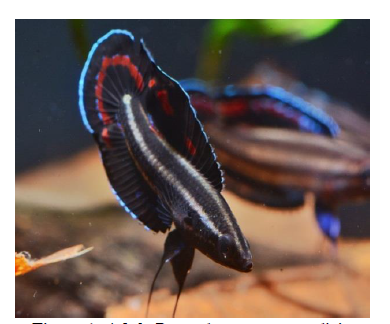Effects of pH, feeding regime and thyroxine on growth and survival of Parosphromenus tweediei (Kottelat and Ng, 2005) fry
DOI:
https://doi.org/10.17762/sfs.v8i1.71Keywords:
pH, Feeding regime, Thyroxine, Parosphromenus tweediei, Total length, SurvivalAbstract
Parosphromenus tweediei is a rare native fish of Malaysia. It is found only in peat swamp areas. Being traded at high market price of MYR40 per fish shows its potential as ornamental fish. Currently, this fish is threatened to extinction due to anthropogenic activities. Particularly when peat swamps are converted into paddy, pineapple or oil palm plantations. To date, there are very few studies on P. tweediei. Culture of this species is non-existent. Therefore, the objectives of this study were to look into several factors affecting the growth and survival of this species in control condition. Aspects studied were on the effect of pH, feeding regime and thyroxine (T4) on growth and survival of P. tweediei fry. Experiments were carried out at Hatchery Unit, Institute of Bioscience, Universiti Putra Malaysia, Serdang, Selangor, Malaysia. Parameters for water quality such as dissolved oxygen, temperature, ammonia, nitrite and nitrate were monitored once a week throughout the experimental period. All experiments were conducted using polystyrene box with size of 34x21x19cm. Experiment on pH consisted of pH 4.5, 5.0, 5.5 and 6.0, which were prepared in triplicates with stocking density of 12 fry per replicate. As for experiment on feeding regime, three regimes used were AM: Artemia nauplii (6-20DAH) - Moina sp. (21-63DAH), AMG1: Artemia nauplii (6-20DAH) - Moina sp. (21-43DAH) - Grindal worm (44-63DAH) and AMG2: Artemia nauplii (6-20DAH) - Moina sp. (27-48DAH) - Grindal worm (49-63DAH). All treatments were triplicated with 10 fry per tank. As for T4 experiment, 3 dosages tested were 0, 0.5 and 1 ppm, conducted in duplicates with 10 fry per tank. Immersions of T4 on 28 DAH fry were carried out only once at the beginning of the experiment. Results showed that fry of P. tweediei can be successfully cultured from pH 4.5 to 6.0. It was observed that total length (TL) and survival increase as pH level decreases from 6.0 to 4.5. As for feeding regime, statistical analysis showed that there were significant differences (p<0.05) among treatments, with AMG2 produced the highest TL (18.91 mm) as compared to the other two treatments. As for T4 experiment, T4 at 0.5ppm produced the highest (p<0.05) TL as compared to 0 and 1.0ppm. Nevertheless, the percentage of survival and water quality were not significantly different (p>0.05) among the treatments in both feeding regime and thyroxine experiments. As a conclusion, P. tweediei fry grow and survive best in acidic water condition. In additions, a single application of T4 at 0.5 ppm is sufficient to induce the growth of P. tweediei at early stage.










